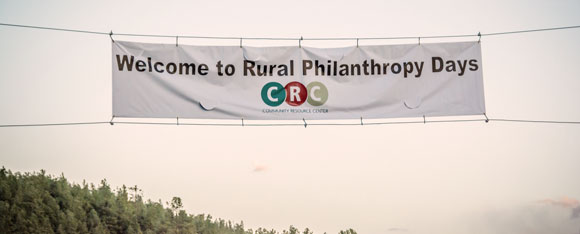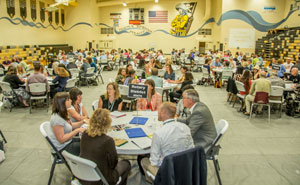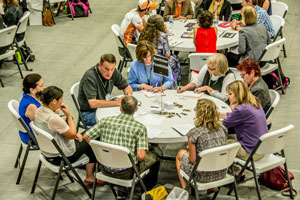Jul 08, 2015
Granting Hope
by Kate Menzies
Colorado Rural Philanthropy Days summons funders, regional governments, and community leaders to provide a platform for positive change in rural nonprofit organizations.

In the 1990's, Sue Anschutz-Rodgers discovered that only about three percent of private grant funds given in Colorado were to communities outside of the populous Front Range region.
"Rural Colorado was left out of the philanthropic picture," said Sue Anschutz-Rodgers, chair and president of the Anschutz Family Foundation.
An Innovative Solution
Rural Colorado was left out of the philanthropic picture.
As a way to fill this gap, the Anschutz Family Foundation and Colorado's Community Resource Center (CRC) teamed up to create Rural Philanthropy Days, with the premise of connecting rural nonprofit organizations with willing grant funders.
For 24 years, Rural Philanthropy Days has brought together regional funders, local governments, business leaders, and local nonprofit organizations to spur positive change in the rural communities of Colorado.
"We reversed the typical process," said Anschutz-Rodgers. "The funders were going to come to people, rather than the people going to the funders."
At the conference, nonprofit attendees are able to attend workshops and improve their skills, as well as network with other nonprofits in the region and establish collaborative ties. The conference allows nonprofit professionals to share and learn from each other's mistakes and how to overcome them.

Program participants are also given the chance to present directly to grant funders and potentially acquire funding.
The result has been an increase in funding to rural Colorado communities and new nonprofit programs cropping up across the state.
"Rural Philanthropy Days provides a good platform to learn about successful program models occurring in different regions throughout the state," said Leah Rausch, Rural Philanthropy Days Program Manager. "This conference helps participants understand how to bring high quality services to rural communities without high costs."
The heart of Rural Philanthropy Days is connecting people across the region.
In order to better educate nonprofits on the various grant opportunities available to them, Rural Philanthropy Days is divided into eight distinct Colorado regions based on unique characteristics and needs. Each region is able to host their own conference every four years, while benefiting from the expertise and planning assistance of the Anschutz Family Foundation and CRC.

This year's conferences include Colorado's Mountain region, held June 24-26, and the San Luis Valley region, coming up on September 23-25. The nonprofit organizations in these regions receive tailored advice on grant opportunities from funders, and will be able to form lasting connections with other nonprofits in their areas.
"The heart of Rural Philanthropy Days is connecting people across the region," said Rausch.
Within the selected regions, one town is chosen to host the conference for the three-day event. Rifle, Colorado of the Mountain Region and Creede, Colorado of the San Luis Valley Region are the sites of the 2015 conferences. Creede is the smallest town to ever host the conference with a population of fewer than 500 people. To put that in perspective, anywhere from 250-400 people are present at a single Rural Philanthropy Days event.
Rausch said the event has been a huge success. Each year, participation grows and the event changes themes. With different locations being selected every rotation, a variety of communities and nonprofits are given the chance to learn something new.
"The event just gets stronger and stronger each year," said Anschutz-Rodgers.
At a 2013 meeting of the Colorado Rural Funders, it was suggested that a funding impact map be constructed to measure the financial impact of the 12 core funders in Colorado's rural regions. The completed impact map is used by both grantseekers and grantmakers to track foundation impacts. In 2014, the 12 rural funders gave nearly $25 million in grant support.
A Model for Rural Philanthropy
"This conference format is definitely replicable in other states," said Rausch. "When implementing a similar conference, keep in mind each state's unique demographics."
Rausch encourages other states wishing to implement a similar conference to take travel restrictions into consideration, as this may hinder the turnout of the event. For Colorado, Rausch speculated that the state's geography has actually worked in the conference's favor.
"Travel barriers create isolated communities in the state, which is what makes the conference all that more impactful for those who attend," said Rausch.
In order to make a similar conference as beneficial, Rausch advises drawing people in by establishing a strong presence of foundations with available grants. She also stressed the importance of incorporating a networking component into the event. Overall, planning well in advance is necessary to create a successful conference, along with gathering local input.
"Locals can really help execute the vision of the conference," said Rausch. "They have their thumb on the pulse of the needs of local communities."
Shedding Light/Giving Hope
This event has been able to sustain itself for almost a quarter of a century, thanks to the positive word of mouth from attendees and funders. The rural focus of the conference sheds light on an often overlooked population of the state.
"This event would not be possible without the support of funders who are truly interested in funding rural communities," said Rausch.
Rural Philanthropy Days has effectively granted hope and opportunity to communities in dire need, while simultaneously changing the landscape of rural nonprofit organizations across the state.
